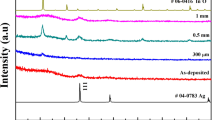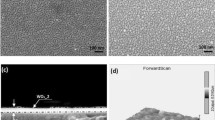Abstract
In this study, we prepared metal oxide-metal-metal oxide (OMO) multilayer transparent electrodes based on indium tin oxide (ITO) and ZnO, viz., ITO/Ag/ITO (IAI) and ZnO/Ag/ZnO (ZAZ) by sputtering and investigated the influence of the thickness of the silver layer as well as the thickness and surface roughness of the metal oxide layers on the optoelectronic performance of the electrodes. The surface roughness of the metal oxide layers affect the critical thickness required to transform the low-conductivity semi-continuous silver films into high-conductivity continuous ones. The thicknesses of the metal oxide layers over and underneath the Ag layer can be modulated not only to enhance the transmittance of the electrodes but also to adjust the position of the maximum transmittance. Optimization of the thicknesses of the metal oxide and Ag layers allows the fabrication of high-quality transparent electrodes. The sheet resistance for the best ZAZ sample was 4.16 Ω/sq while the average transmittance (including glass) was 73.09% in the visible region. For IAI electrodes, the sheet resistance and the average transmittance in the visible region were 5.85 Ω/sq and 82.12%, respectively. The Haacke index indicated that for applications with high optical demands, the Ag film thickness should be 8.5 nm and 13.0 nm for ITO and ZnO systems, respectively. Moreover, semi-continuous Ag layers are bluish due to surface plasmon resonance. This study defines a criterion for determining the optimal thickness of Ag layers in OMO films.











Similar content being viewed by others
References
D.S. Ginley, C. Bright, Transparent conducting oxides, MRS Bulletin 25(8), 15–18 (2000)
K. Ellmer, Past achievements and future challenges in the development of optically transparent electrodes. Nat. Photonics 6, 808–816 (2012)
J. Hautcoeur, X. Castel, F. Colombel, R. Benzerga, M. Himdi, G. Legeay, E. Motta-Cruz, Transparency and electrical properties of meshed metal films. Thin Solid Films 519, 3851–3858 (2011)
J.Y. Lee, S.T. Connor, Y. Cui, P. Peumans, Solution-processed metal nanowire mesh transparent electrodes. Nano Lett. 8(2), 689–692 (2008)
X. Wang, L. Zhi, K. Müllen, Transparent, Conductive graphene electrodes for dye-sensitized solar cells. Nano Lett. 8(1), 323–327 (2008)
S. Kirchmeyer, K. Reuter, Scientific importance, properties and growing applications of poly(3,4-ethylenedioxythiophene). J. Mater. Chem. 15, 2077–2088 (2005)
E. Kusano, J. Kawaguchi, K. Enjouji, Thermal stability of heat-reflective films consisting of oxide–Ag–oxide deposited by dc magnetron sputtering. J. Vac. Sci. Technol. A 4(6), 2907 (1986)
M. Bender, W. Seelig, C. Daube, H. Frankenberger, B. Ocker, J. Stollenwerk, Dependence of film composition and thicknesses on optical and electrical properties of ITO–metal–ITO multilayers. Thin Solid Films 326, 67–71 (1998)
M. Girtan, Comparison of ITO/metal/ITO and ZnO/metal/ZnO characteristics as transparent electrodes for third generation solar cells. Sol. Energy Mater. Sol. Cells 100, 153–161 (2012)
D.R. Sahu, S.Y. Lin, J.L. Huang, ZnO/Ag/ZnO multilayer films for the application of a very low resistance transparent electrode. Appl. Surf. Sci. 252, 7509 (2006)
C.W. Joo, J. Lee, W.J. Sung, J. Moon, N.S. Cho, H.Y. Chu, J.-I. Lee, ITO/metal/ITO anode for efficient transparent white organic light-emitting diodes. Jpn. J. Appl. Phys. 54, 02BC04 (2015)
K.P. Sibin, N. Selvakumar, A. Kumar, A. Dey, N. Sridhara, H.D. Shashikala, A.K. Sharma, H.C. Barshilia, Design and development of ITO/Ag/ITO spectral beam splitter coating for photovoltaic-thermoelectric hybrid systems. Sol. Energy 141, 118–126 (2017)
K.H. Choi, J.Y. Kim, Y.S. Lee, H.J. Kim, ITO/Ag/ITO multilayer films for the application of a very low resistance transparent electrode. Thin Solid Films 341, 152–155 (1999)
C. Guillen, J. Herrero, ITO/metal/ITO multilayer structures based on Ag and Cu metal films for high-performance transparent electrodes. Sol. Energy Mater. Sol. Cells 92, 938–941 (2008)
A.A. Dakhel, Optical properties of highly conductive and transparent Au-incorporated Eu oxide thin films. J. Alloys Compd. 470, 195–198 (2009)
Z. Wang, X. Cai, Q. Chen, L. Li, Optical properties of metal-dielectric multilayers in the near UV region. Vacuum 80, 438–443 (2006)
K. Fuchs, The conductivity of thin metallic films according to the electron theory of metals. Proc. Camb. Philos. Soc. 34, 100–108 (1938)
E.H. Sondheimer, The mean free path of electrons in metals. Adv. Phys. 1, 1–42 (1952)
J.M. Purswani, D. Gall, Electron scattering at single crystal Cu surfaces. Thin Solid Films 516, 465–469 (2007)
D. Gall, Electron mean free path in elemental metals. J. Appl. Phys. 119, 085101 (2016)
G. Haacke, New figure of merit for transparent conductors. J. Appl. Phys. 47, 4086 (1976)
Acknowledgements
The authors gratefully acknowledge the financial support provided by the Ministry of Science and Technology of Republic of China under contact number MOST 105-2221-E-218-033.
Author information
Authors and Affiliations
Corresponding author
Rights and permissions
About this article
Cite this article
Lin, KM., Lin, RL., Hsiao, WT. et al. Effects of the structural properties of metal oxide/Ag/metal oxide multilayer transparent electrodes on their optoelectronic performances. J Mater Sci: Mater Electron 28, 12363–12371 (2017). https://doi.org/10.1007/s10854-017-7056-6
Received:
Accepted:
Published:
Issue Date:
DOI: https://doi.org/10.1007/s10854-017-7056-6




